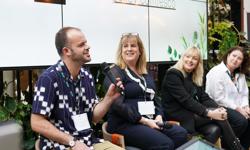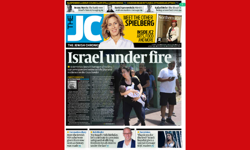With the PPA’s centenary celebrations out the way, there was a sense of looking forward to the next hundred years coupled with a realisation that the nature of magazine publishing would change dramatically over the next century, with the next couple of years being pivotal.
Seize the moment
PPA chairman Kevin Costello spoke of now being a key moment. DC Thomson chief executive Ellis Watson, in a barnstorming presentation, said that the “success of our industry over the next twenty years would be determined by our actions in the next two”.
Newly appointed CEO at IPC Media, Marcus Rich, warned that we were all standing on a “burning platform” and that our core business models were about to undergo significant change.
Ellis Watson said we must be careful not to delude ourselves as to the scale of the task before us. He produced sales figures that highlighted the massive decline in our industry over the past seven years. In 2007, 1.21 bn magazines were bought in the UK. By 2010, that figure had dipped below the one billion mark. In 2013, the figure stood at 781m. But, he said, the magazine industry is still “in quite good shape and there is still time to learn”. When confronting the digital challenge, magazine publishers had shown themselves to be neither as “suicidal as newspapers nor as arrogant as the music business”, but we still had to be realistic about the future and we had to do things differently, because, after all, “the definition of madness is to continue to do the same thing over and over again and expect a different result”.
Put the knives away
One key thing we need to do differently is to stop seeing other publishers as the enemy and to start working collaboratively to promote the magazine medium as a whole, to agencies and clients.
This theme was discussed at some length in the Advertising Matters panel session. David Wilding, head of planning at PHD, but soon to join Twitter, put his finger on it when he said: “attention is finite and everything is battling for people’s attention”. Phil Thomas, CEO of Cannes Lions said, “publishers need to work together more; put the knives away. The threat is not so much other publishers as other media.” Jane Wolfson, joint head of investment and media owner relations at Initiative, pointed out that the newspaper industry, which was even more fiercely competitive than the magazine industry, worked much more cohesively together through Newsworks – the body set up to promote the newspaper medium to the advertising community.
What was needed was a continuous stream of research and data aimed at advertisers, demonstrating the extraordinary value of magazines (both in print and online) as a promotional vehicle for brands.
We need to big ourselves up, for whilst Kevin Costello spoke of the “deep passion and fierce pride” felt by magazine publishers, Ellis Watson had also detected a tendency to talk ourselves down, to talk about our supposed weaknesses rather than our considerable strengths. Now was the time, said Ellis, “to get off our pessimistic arses; we need to stop looking down and back and start looking up!” Bauer Media group MD advertising, Richard Dunmall, said it was “our responsibility to reignite interest and passion with agencies rather than simply saying ‘woe is me’.”
The PPA had obviously already taken this message on board, because Kevin Costello used the event to announce the imminent setting up of a new independent marketing agency, along the lines of Newsworks, which will promote the use of consumer magazines to agencies and clients.
All about the brand
In the same way that Newsworks talks about ‘newsbrands’, one wonders if the new as-yet-unnamed agency will be promoting ‘magbrands’.
Certainly, Immediate Media CEO Tom Bureau discourages the use of the words ‘magazine’ or ‘publishing’ in his company. Tom sees the businesses as brands and he talks about them being on a “brand journey”. For their 70+ brands, which are mostly multi-platform, a new business model is coming through, and it’s all centred on “deep engagement with our customers”. IPC’s Marcus Rich talks of building “inspired conversations” with his customers based round an “incredibly deep two-way dialogue with a community of people. Out of that deep engagement, IPC will build new businesses.” Kirsty Setchell, also of IPC, spoke in the Generation Next session, about “integrating brands into the lives of the reader”. Bauer’s Dunmall also spoke of “extending the ways in which we engage with the audience and then monetising those different engagement points”.
Events are one way of monetising the direct relationship with a reader, and Woman’s Weekly editor Diane Kenwood talked about the enormous brand value of the experiential events they have launched over the past year, some large (Woman’s Weekly Live!) and some small – like workshops and masterclasses (Christmas Cake Decorating Day, Learn to Chrochet).
The key point is that, if you are fully engaged with your audience, then there are a thousand and one ways you can monetise that relationship. The important thing is building those connections and then having the company culture and resource capable of tailoring a commercial offering for them.
Back to basics
Whilst cultivating the multitude of different touchpoints we have with our audiences, and developing new ways to monetise those touchpoints, publishers need to take care not to forget the primacy of content, for it is that which sets us apart. At the “heart of any consumer media business is outstanding people that generate engaging content”, said Marcus Rich.
When Natasha Christie-Miller was appointed CEO of Emap three years ago, the company was distracted by questions of technology platform and other secondary considerations. The company had lost sight of its core purpose which was producing high value content.
“Our obsession with technology is getting ridiculous”, said Ellis Watson. “It is vital for publishers to get back to basics and remember what publishing is all about. It is the job of every journalist and publisher to get out there and deliver exciting compelling content.”
And, video and audio notwithstanding, content more often than not means ‘words’. Red editor-in-chief Sarah Bailey wanted to remind her audience of the “deep pleasure of reading”. Earlier in the day, Tony Parsons had six words of advice for any aspiring journalist and they weren’t “learn how to shoot better video”, they were “read, read, read, write, write, write”. The sessions with Mark Ellen, Tony Parsons and Victoria Coren Mitchell demonstrated the amazing facility with words that top columnists have and that it is great words, expertly crafted that ultimately distinguishes our output from the tsunami of cannon fodder content out there.
Tony Parsons said that magazines were needed now more than ever: “the internet shows that anyone can do it, but not anyone can do it well. Magazines’ ability to select thirty stories from the millions out there, to explore them and to present them dramatically was absolutely invaluable.”
But are some publishers losing sight of this?
A cut too far?
It has been written about often enough in InPublishing, but there is a danger that, in their zeal to cut costs and their perhaps understandable desire to explore all the opportunities of multi-platform publishing that some publishing companies are cutting editorial budgets to the point where they can no longer produce the distinctive content, without which the publisher will have no future, whatever the platform.
Ellis Watson said that it’s the journalists and creatives who ultimately deliver the value: “you can’t burn the floorboards to keep warm!”
Shrinking editorial teams, the increasing demands being made on them and declining freelance budgets could all combine to turn once proud editorial teams into little more than content farms.
When asked what kept her awake at night, Woman’s Weekly’s Diane Kenwood cited concerns over the ever increasing demands she is placing on her editorial team.
Going native
One of those increasing demands comes from the commercial teams, as more and more publishers offer bespoke sponsored content opportunities, where the close involvement of editorial is one of the principal attractions to the sponsoring company.
Richard Dunmall spoke of the continuing blurring of the lines between content and commerce. Jane Wolfson was pleased to note that “publishers are now more eager to work editorially and that conversations are no longer just about the ad page, which will continue to decline”.
Work pressures aside, there seemed to be widespread agreement that native advertising was a win-win.
Bauer’s experience with its recently launched email newsletter, The Debrief, was that audiences were “quite happy with the native advertising model as long as value was added. Properly labeled native ads are a big part of our strategy – another way of monetising our audience in a way they like”, said Richard Dunmall.
Red’s Sarah Bailey sounded a note of caution: “There is a bond of trust and readers want to know that the editor is independent.” This suggests that there is a limit to how much native advertising a magazine can introduce before it will start to have a detrimental impact on wider brand values.
Period of constant change
As Centaur CEO Andria Vidler said: “Everything in the world is changing rapidly, why should publishing businesses be any different?” Changing the skills set, instilling an acceptance of change and finding new ways of working were all seen as critically important. Immediate’s Tom Bureau spoke of “creating a culture and value set and then asking people if they wanted to be part of it.” Some didn’t and they were encouraged to find new jobs. Of Immediate’s 900 staff, 300 of them had been at the company less than one year and I imagine the company is well on its way to reaching the tipping point Tom identified, whereby more people are engaged with the new corporate direction than not. To help him enact this process of change, Tom employs the services of a leadership and change management consultancy.
Marcus Rich also spoke of the need for “collective buy-in” and even had a book tip for us. For anyone interested in managing a process of change, he said, then Who moved my cheese? by Spencer Johnson is a particularly good read.
Conclusion
The final session of the day was an interview with tyro publisher Jamie Cullum, who this year launched The Eighty-Eight, a collection of “essays, stories and pictures curated by Jamie Cullum”. His enthusiasm was like a breath of fresh air. He couldn’t imagine his life without magazines. His first publishing venture was called ARM (All Round Magazine) which he launched at home, aged six. He wants his magazine to “exist as an object of desire”. And magazines “seem more important than ever; people are coming back to the physical form”. I’m not entirely sure what he based that last one on, but who cares! With his passion, The Eighty-Eight (current sales, a thousand or so) has a fighting chance!












